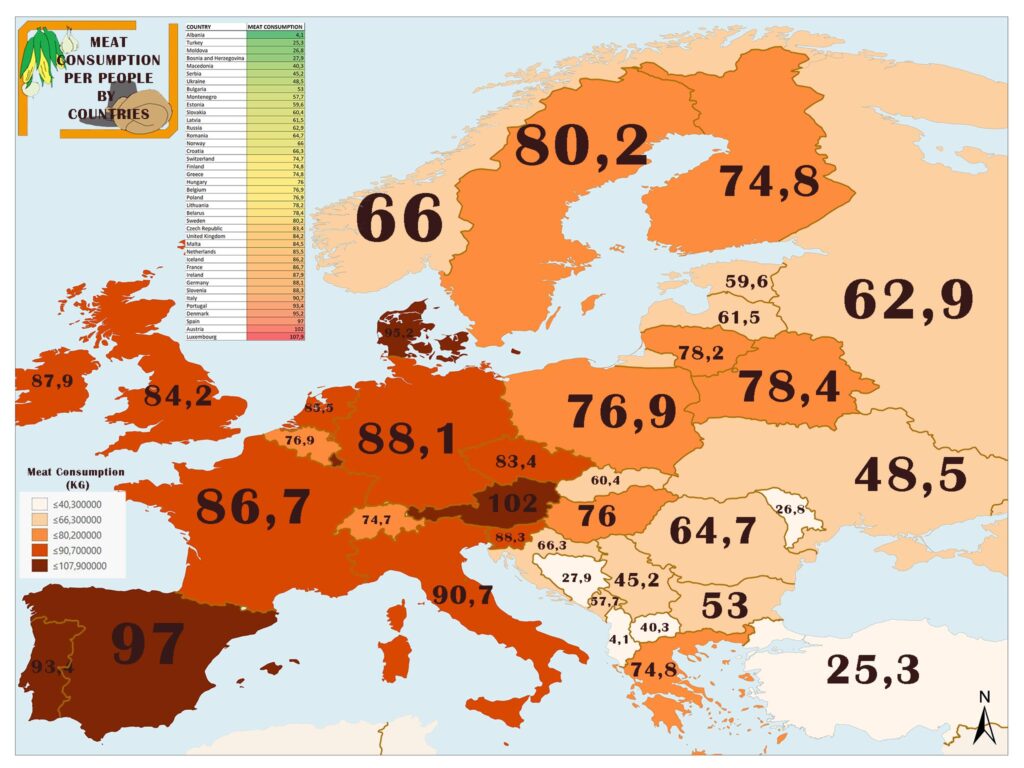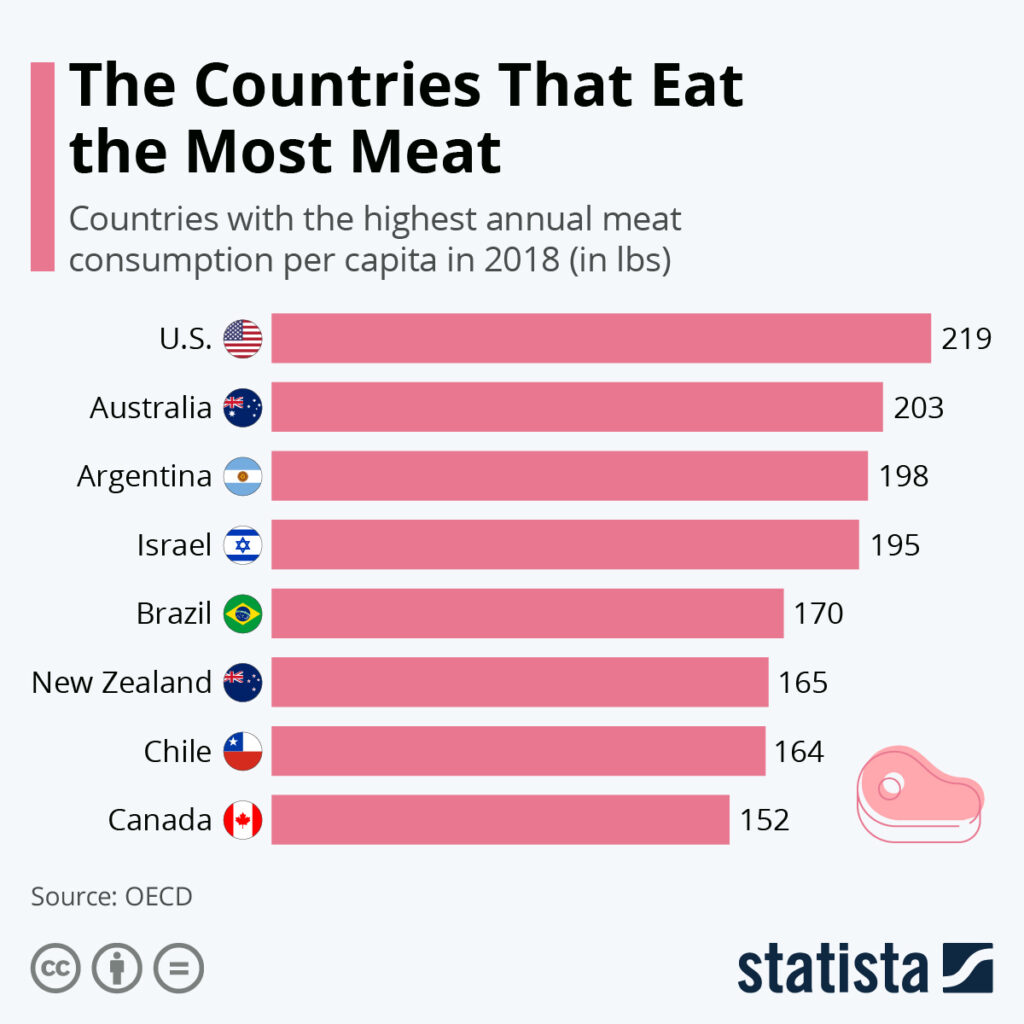According to the Data Which Countries May Be Supplying Beef to These 2 Countries
According to the US Food and Agricultural Policy Research Institute the average per capita meat consumption per person in the world was 38.7 kilograms.
Meat Consumption in the EU
Consumption of meat per capita in EU countries was about 77.1 kilograms.
The below map shows the meat consumption by countries per capita in Europe. Countries with the highest yearly meat consumption per-capita are Austria, Spain, Denmark, Luxembourg, and Portugal.

In contrast, the average annual per capita meat consumption is least in Albania, Turkey, Moldova, and Bosnia and Herzegovina.
Islam may be associated with reduced meat consumption in Turkey and Bosnia. Pork is often consumed in Europe, and because it is low in price, it is easily accessible.
In these Muslim societies, pork is never consumed. Instead, people consume, cattle or sheep meat, which is a more expensive meat type.
Meat Consumption Globally

The United Nations Food and Agriculture Organization predicts that meat consumption will increase continually. This rise harms the environment since animals that produce meat overgraze and erode the soil.
As the world's population grows, farmers have to level up meat production. In the past 50 years, meat production has increased more than three times, totaling over 340 million tons of meat.
Types of Meat Recorded
A study conducted by Curtin University in Australia tracked meat consumption across the globe. The patterns tracked occurred between 2000 and 2019. They recorded data about certain meats, including:
- beef
- pork
- poultry
- sheep meat
Eating less beef decreases carbon pollution, and the total beef consumption has trended down in most countries. Several countries, including Indonesia, China, and the United Kingdom, haven't changed how much beef they eat. In countries like Vietnam, Turkey, Saudi Arabia, Ethiopia, and Israel, beef consumption increased.
Pork consumption increased in most countries studied, including China, Vietnam, Australia, Japan, and Korea. Still, it wasn't the meat that has seen the most increase in consumption in recent history.
That title goes to poultry. Poultry consumption doubled in 13 countries studied between 2000 and 2019. While beef and pork consumption decreased overall, poultry consumption increased to cover those gaps and then some.
Sheep meat was also seen to decrease in the majority of countries studied. Its consumption increased in a few cases, as in China, Israel, Korea, and Thailand.
The researchers at Curtin University note that fish consumption has also increased. For the sake of simplicity, researchers excluded fish from this study.
Meat Consumption by Country and Per Capita
| Country | kg per capita in 2019 |
|---|---|
| United States | 100.9 |
| Israel | 90 |
| Australia | 89.6 |
| Argentina | 88.3 |
| Chile | 81.3 |
| Brazil | 78.9 |
| New Zealand | 75.2 |
| Canada | 70.2 |
| OECD | 70.1 |
| Russia | 62.5 |
| Korea | 62.1 |
| United Kingdom | 61.5 |
| Malaysia | 60.4 |
| Norway | 56 |
| Peru | 54.7 |
| Mexico | 54.6 |
| Switzerland | 51.6 |
| South Africa | 51.6 |
| Viet Nam | 50.5 |
| Kazakhstan | 49.1 |
| Colombia | 48.9 |
| China (People's Republic of) | 45.7 |
| Saudi Arabia | 43.6 |
| Japan | 41.6 |
| Ukraine | 40.1 |
| Paraguay | 39.5 |
| World | 34 |
| Iran | 33.2 |
| Turkey | 32.8 |
| Philippines | 32.4 |
| Egypt | 20 |
| Thailand | 19 |
| Pakistan | 15 |
| Indonesia | 11.4 |
| Nigeria | 5 |
| India | 3.6 |
| Ethiopia | 3.1 |
Some Country Highlights
United States of America
It's no surprise that the United States of America tops the list of meat consumption. Though the country is eating less beef than ever before, they're consuming just as much pork and even more poultry.
American citizens eat more than 124 kg of meat annually. To get a better picture of the amount of meat, 100 kg equals half a cow and 50 chickens for each person. The North American Meat Institute found that American men eat 4.8 ounces (0.18 kg) of meat every day, while women eat 3 ounces (0.11 kg), on average.
America is a wealthy country with a rising population, so they consume a large portion of the world's meat. The country also produces a lot of meat – almost 47 million tons annually, as of 2018.
Related: Wealthiest Countries in the World
The United States is the world's largest producer of beef, though the country's consumption of that meat has trended down in recent years. The country exports its beef globally, with the top four markets being Hong Kong, Japan, Mexico, and South Korea.
Australia
Australia is close behind the United States in meat consumption. If you track the total consumption over the years, there are more notable increases and decreases. On average, Australians eat 121 kg of meat per year.
Australia produces two million tons of beef annually, but the country has seen a large increase in poultry consumption. If you're wondering which country eats the most chicken, Australia is the answer. The farmers can produce enough poultry domestically, so there's no need to import as much meat.
Sheep meat is another export Australia shares with the world. They send the meat to China and the Middle East. But Australians don't eat much of this meat, instead consuming beef and veal.
Argentina
People in Argentina eat about 109 kg of meat per year. In the past, they've been the country with the second-highest consumption of beef – Uruguay is the first. It's cheap to raise cows in Argentina, and there's plenty of room for them to grow without the need for steroids.
The country is at an advantage in terms of exports and has plenty of beef to ship to other nations. However, prices have increased due to inflation, so many citizens can't afford the local meat.
This inflation has Argentina's rates of beef consumption slowly but steadily decreasing, from 60kg per person to under 56kg since 2014. The country's overall meat consumption has increased, though, as citizens switch their diets to include more poultry and pork.
United Kingdom
People in the United Kingdom eat almost 80 kg of meat annually. The country's meat consumption dropped in 2022 as people stopped eating as much red meat. Though they started eating more poultry and pork, they didn't eat enough to make up the difference.
The government has encouraged citizens to decrease their meat consumption even more. They need the farmland and want to slow their carbon footprint as well. The government adds that eating less meat is also healthier for people's lifestyles.
Japan
Japan is a unique country to research because citizens' wealth has increased, yet their meat consumption has decreased. Citizens now eat less than 80kg of meat a year. The government attributes the decrease to the country's aging population.
Elderly people aren't eating as much meat because of their health and to conserve their money.
China
China's meat consumption increased by more than 70% since 1998. This jump in consumption made the country responsible for 34% of the entire world's growth in meat consumption. Most of the increase was due to population growth, but the economy also played a part.
Pork is the most consumed meat in China, with poultry close behind. Beef and sheep meat make up the rest of their meat consumption in small portions. Chinese citizens eat about 60 kg of meat every year.
China produces most of the world's meat, averaging 88 million tons a year. The United States is in second place, but still far behind with under 47 million tons produced a year. The other countries on this list don't come close, producing anywhere from one to seven million tons of meat annually.
Uruguay
As previously mentioned, Uruguay is the country with the highest rate of beef consumption. The country's overall annual meat consumption, however, is only 57.6 kg per person.
Most of the meat consumed in the country is beef, though citizens do also eat poultry, pork, and, to a lesser degree, sheep meat.
Indonesia
Indonesia accounts for only 3% of meat consumption. The country's population has grown, as has the economy, so their meat consumption doubled. Still, it hasn't risen in the rankings of other countries around the world.
Farmers in Indonesia must limit meat production due to land constraints, so the country imports meat from around the world. Most of the meat Indonesians eat is poultry, at less than 8kg annually. They consume 2.2kg of beef but only 1kg of pork since pig meat it's forbidden for most citizens to eat.
Ethiopia
Ethiopia is another country with low rates of meat consumption at 8kg annually. Citizens limit the types of meat they can eat due to their culture. Meat is also expensive in the country, so it's reserved for special occasions. When Ethiopians eat meat, it's usually beef, though they do consume small portions of poultry.
Nigeria
Nigeria has a low rate of meat consumption at about 7kg per person annually. The amount is mostly beef, sheep meat, and pork. Nigerians eat only 1kg of poultry per year. Most of their diet is fish, though their beef consumption has risen over the past few years.
India
In India, almost 40% of citizens are vegetarians, and 80% of the population restricts their meat consumption. Due to culture and religion, many people won't eat meat on certain days or only eat certain types of meat.
When you look at the types of meat Indians eat, poultry is at the top of the list, with 2.2 kg consumed annually per person. Beef is 0.76 kg, sheep meat is 0.44 kg, and pork is the lowest, at 0.25 kg.
Worldwide
Worldwide meat consumption has increased by about 20 kg in the past 50 years. The average person eats over 40 kg of meat per year. That's a high average, considering people in India have held steady at less than 4 kg per person throughout that time.
The increase is mostly affected by population growth, but consumption is also increasing per person. The per-person increase also impacted which meats were more popular, such as the rise in poultry consumption over beef.
The demand for meat is dropping for environmental reasons. Many countries' governments plead with their citizens to eat less beef to reduce their carbon footprints. With skyrocketing prices and supply issues, there may be a shift in people's diets across the globe.
Final Notes
China's increase in meat consumption represents a large portion of the world's growth. Overall, the result of which country eats the most meat depends on the population, as in China's case. It's also a factor of relative wealth, as shown by the United States and Australia.
With protein being such an important part of a healthy diet, it's unlikely that meat consumption will drastically drop anytime soon. Changing trends in the types of protein, however, are something to watch.
Source: https://www.mappr.co/thematic-maps/meat-consumption-by-countries/
0 Response to "According to the Data Which Countries May Be Supplying Beef to These 2 Countries"
Post a Comment